Afro-migrants through newspapers from the Global South: “criminals”, “samaritans” and “victims”
DOI:
https://doi.org/10.5007/1984-8412.2023.e86563Keywords:
Migration, Discourse, Representation, Blackness, Global SouthAbstract
This paper examines forms through which black/Afro-descendant migrants are represented in a newspaper from Brazil and another from South Africa, mostly considering meaning effects on the construction of race and ethnicity in news articles published by both media outlets in 2015. This work also uses Corpus Linguistics and Critical Discourse Analysis in order to deal with the verbal language of both periodicals. Preliminary conclusions suggest that black/Afro-descendant migrants are represented from the perspective of criminality, either as victims or agents of illegality. Furthermore, these subjects are generally positioned as mere beneficiaries of solidarity, particularly in the case of Brazil, or as offenders in the case of the South African newspaper. Although a passivizing representation is common between the two outlets, the Brazilian newspaper employs more editorial resources of reported speech on migrants, while the South African newspaper either silences them or applies fewer editorial strategies.
References
BAKER, P.; LEVON, E. ‘That’s what I call a man’: Representations of racialized and classed masculinities in the UK print media’. Gender and Language, v. 10, n. 1, p. 106-139, 2016.
BLOMMAERT, J. Discourse: a Critical introduction. Cambridge: CUP, 2005.
BOFF, L. O caminhar da igreja com os oprimidos: do vale das lágrimas à terra prometida. Rio de Janeiro: Codecri, 1981.
CHAN, W. News media representations of immigrants in the Canadian criminal justice system. Metropolis British Columbia, v. 13, n. 3, p. 1-46, 2013.
CLAASSEN, C. Explaining South African xenophobia. Afrobarometer, v. 1, n. 173, p. 1-25, 2017.
COWARD, R.; ELLIS, J. Language and materialism. London: Routledge, 1977.
COX, R. Towards a post-hegemonic conceptualization of world order: reflections on the relevancy of Ibn Khaldun. In: ROSENAU, J.; CZEMPIEL, E. (org.). Governance without government: order and change in world politics. Cambridge: Cambridge University Press, 1992. p. 132-159.
DUGNANI, B. Imagens discursivas de imigrantes e suas implicações no discurso de receptividade do brasileiro na imprensa nacional: uma perspectiva dialógica. 2017. 367f. Tese (Doutorado em Linguística Aplicada e Estudos da Linguagem) – Programa de Pós-Graduação em Linguística Aplicada e Estudos da Linguagem, Pontifícia Universidade Católica de São Paulo, São Paulo, 2017.
FAIRCLOUGH, N. Media Discourse. London: Edward Arnold, 1995.
FAIRCLOUGH, N. A dialectical-relational approach to Critical Discourse Analysis in Social Research. In: WODAK, R.; MEYER, M. (org.). Methods in Critical Discourse Analysis. Thousand Oaks: Sage, 2015. p. 119-148.
FOUCAULT, M. A ordem do discurso. São Paulo: Edições Loyola, 2010.
GITLIN, T. The whole world is watching: Mass Media in the making and unmaking of the New Left. Los Angeles: University of California Press, 1980.
HALL, S. Media power and class power. In: CURRAN, J. et al. (org.). Bending reality: the state of the media. London: Pluto Press, 1986. p. 5-14.
HALL, S. Encoding, Decoding. In: DURING, S. (org.). The Cultural Studies reader. London: Routledge, 1991. p. 507-517.
HANSEN, A.; MACHIN, D. Media and Communication Research Methods. 2. ed. London: Red Globe Press, 2019.
HIERRO, G. Ética y feminismo. Mexico City: UNAM, 1990.
HUDSON-WEEMS, C. Africana Womanism: reclaiming ourselves. New York: Bedford, 1993.
KARENGA, M. Kwanzaa: a celebration of family, community and culture. Los Angeles: Uni-SaP, 1998.
MACHIN, D. Introduction to Multimodal Analysis. London: Bloomsbury, 2007.
MAWADZA, A. The Zimbabwean threat: media representations of immigrants in the South African media. 2012. 225f. Tese (PhD in Linguistics, Language and Communication) – Department of Linguistics, University of the Western Cape, Cape Town, 2012.
McDONALD, D.; JACOBS, S. (Re)writing xenophobia: understanding press coverage of cross-border migration in Southern Africa. Journal of Contemporary African Studies, v. 23, n. 3, p. 295-325, 2005.
McNAIR, B. Cultural Chaos: Journalism and Power in a Globalised World. London: Routledge, 2006.
MIGNOLO, W. The Global South and world dis/order. Journal of Anthropological Research,v. 67, n. 2, p. 165-188, 2011.
MOORE, K.; CLIFFORD, S. The gendered use of the media by asylum seekers in Britain. Gender and Development, v. 15, n. 3, p. 451-466, 2007.
NYAMNJOH, F. Racism, ethnicity, and the media in Africa: reflections inspired by studies of xenophobia in Cameroon and South Africa. Africa Spectrum, v. 45, n. 1, p. 57-93, 2010.
O’NEILL, D.; HARCUP, T. What is News? Journalism Studies, v. 18, n. 12, p. 1470-1488, 2017.
RASINGER, S. Lithuanian migrants send crime rocketing: representation of ‘new’ migrants in regional print media. Media, Culture & Society, v. 32, n. 6, p. 1021-1030, 2010.
TOGNINI-BONELLI, E. Corpus Linguistics at work. Atlanta: John Benjamins, 2001.
YANG, J. Representations of immigrant students in Canadian print news media: a Critical Discourse Analysis. Critical Intersections in Education, v. 2, n. 1, p. 27-43, 2014.
Downloads
Published
Issue
Section
License

This work is licensed under a Creative Commons Attribution-NonCommercial-NoDerivatives 4.0 International License.
Rights including those in copyright in the content of the published works are owned by Revista Forum Linguistico. Complete or parcial reprint should be authorized by the Editorial Board of the Journal. In case of authorization, the source of the original publication must be stated.


